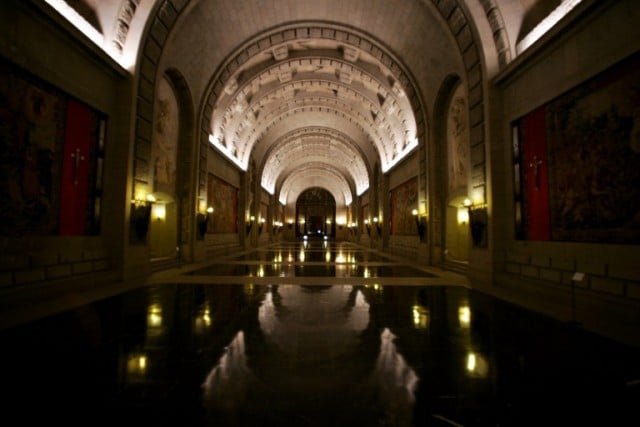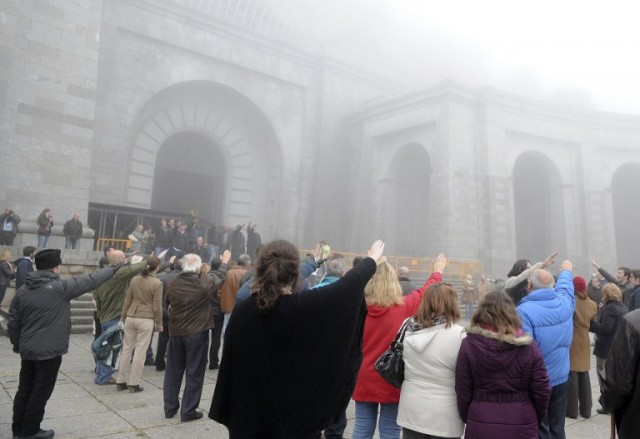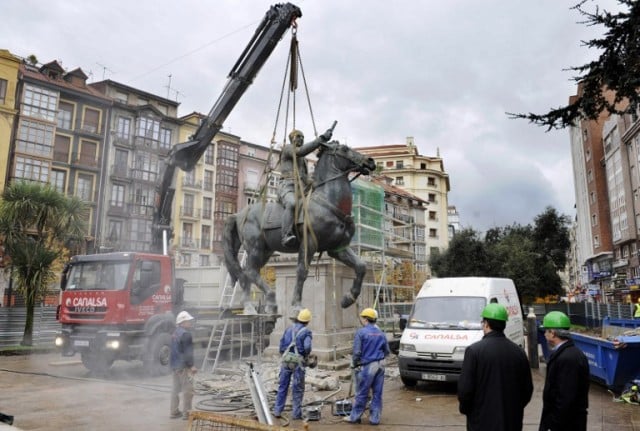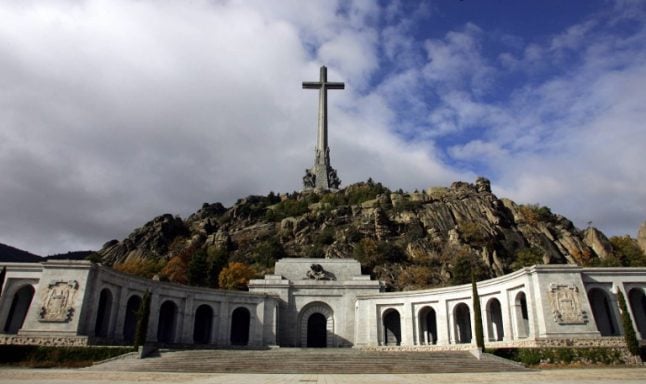Spain’s lawmakers are expected to approve a motion urging the government to begin the process that will see the controversial site transformed from a monument glorifying the fascist dictator into a place of reflection and reconciliation that “acknowledges the victims of the civil war and ensuing dictatorship”.
But will this actually result in the exhumation of Spain’s most controversial leader?
The Local takes a look at the issue:
What exactly is the Valley of the Fallen?
 The basillica was hewn out of the living rock by Republican prisoners. Photo: AFP
The basillica was hewn out of the living rock by Republican prisoners. Photo: AFP
It is a huge basilica carved out of the living rock on a hillside 50km (30 miles) northwest of Madrid. The complex in the Guadarama hills is spread out over 13.6 square kilometres and is surrounded by pine forests. It includes a colossal esplanade leading to the colonnades and the entrance to the basilica.
It’s eerie interior is reached through airport-style security gates past a “museum shop” into a vast vaulted and domed space with black marble floors and walls lined with faded apocalyptic tapestries. Helmeted militaristic statues keep a watchful eye over worshippers and sword-bearing angels stand sentry to chapels dedicated to the armed forces.
The complex also includes a Benedictine abbey and the monks are still responsible for maintaining the site. Mass is held on Sundays.
A giant granite cross, reaching a height of 150 meters (500 ft) crowns the complex and is visible for miles on a clear day from vantage points in the capital.
Who is buried there?
.jpg)
Franco's tomb is always laid with fresh flowers. Photo: AFP
In the centre of the basilica either side of the altar and beneath a gold mosaic dome illustrated with scenes from the Bible are two tombs; that of General Francisco Franco and Jose Antonio Primo de Rivera, the founder of the fascist Spanish Falange party.
Freshly cut flowers are always to be found laid atop each tombstone.
Crypts on either side contain the remains of an estimated 50,000 people who were killed in the Spanish Civil War, including those of Republican supporters whose corpses were dug up after the conflict and added in order to fill the huge crypt.
Who built it?
On April 1st, 1940, a year after the end of the Civil War, General Franco announced plans for the Valle de los Caidos (Valley of the Fallen), a project to establish “a place of rest and meditation to perpetuate the memory of those who fell in our glorious Crusade.”
Pedro Muguriza, one of the leading Spanish architects of the time was charged with the design, and he enlisted Diego Méndez to assist.
Republican prisoners were drafted in to dig the site out of the granite mountainside where they lived in work camp conditions on site. Many died during construction before it was finally completed in 1958. Estimates range from 15 (according to regime officials) to 27,000.
Who goes there?

Supporters gather at the Valley of the Fallen in 2012 to honour Franco with the fascist salute on the anniversary of his death. Photo: AFP
Each year on November 20th the Francisco Franco Foundation has organized a mass to commemorate the anniversary of the death of dictator in 1975. The site has served as a rallying point for supporters of Franco and neo-fascist groups, although such displays are now outlawed under the Historical Memory Law (of which more later).
Apart from die-hard fascists and those wishing to pay their respects to the late Generalissimo, the site is also popular with tour groups with coach loads arriving each day after visiting the nearby San Lorenzo de El Escorial.
The site attracts around 240,000 visitors each year, making it one of the top tourist attractions in the Madrid region and the fourth most visited site managed by Spain’s National Heritage Trust.
Many of those whose relatives died fighting Francoist forces swear never to set foot there.
Why the controversy?
Well, aside from the fact that it was built by the slave labour of those who opposed the regime and contains the unidentified remains of tens of thousands of those killed by Francoist forces during the Civil War, now lying jumbled up alongside the remains of those they opposed, such a memorial is arguably against the law.
The Historical Memory Law, introduced in 2007 under the socialist government of Jose Luis Rodriguez Zapatero in an attempt to heal the wounds of the past, banned public symbols that honoured the dictator and his supporters.

This statue of Franco was removed from the city of Santander in 2008. Photo: AFP
While street names have been changed and statues of Franco removed from public squares, the most symbolic memorial of the era has remained untouched.
READ MORE: Madrid banishes ghost of Franco from its streets with name changes.
But victims' associations say the continued existence of the memorial is “an insult to modern democratic Spain”. At the very least, Franco should be dug up and removed from the site, they say.
Some have called for the entire site to be blown up while others insist it would be enough if it was transformed into a centre for reconciliation that provided an accurate account of its history.
“We believe that the State is subjecting the dictatorship's victims to a form of mistreatment and humiliation by obligating them to pay through their taxes for dictator Francisco Franco's tomb, which is sustained through public funds,” the Association for the Recovery of Historical Memory (ARMH) has told The Local.
What next?
The Socialist Party has proposed a motion calling for Franco’s remains to be buried elsewhere and for the site to be transformed “so that it stops being a place of Francoist and National-Catholic memory and becomes a space for a culture of reconciliation, democratic collective memory, and dignifies and acknowledges the victims of the civil war and the dictatorship”.
All political parties have said they will support the motion, except the governing Popular Party of Mariano Rajoy which will oppose it. But as the PP does not have a majority in the 350 seat parliament it is likely to sail through.
However…
Approval of the motion would only be symbolic, and the government is not legally bound to have to implement any of the measures. So it depends on whether the government of Mariano Rajoy feels under significant public pressure to act.


 Please whitelist us to continue reading.
Please whitelist us to continue reading.